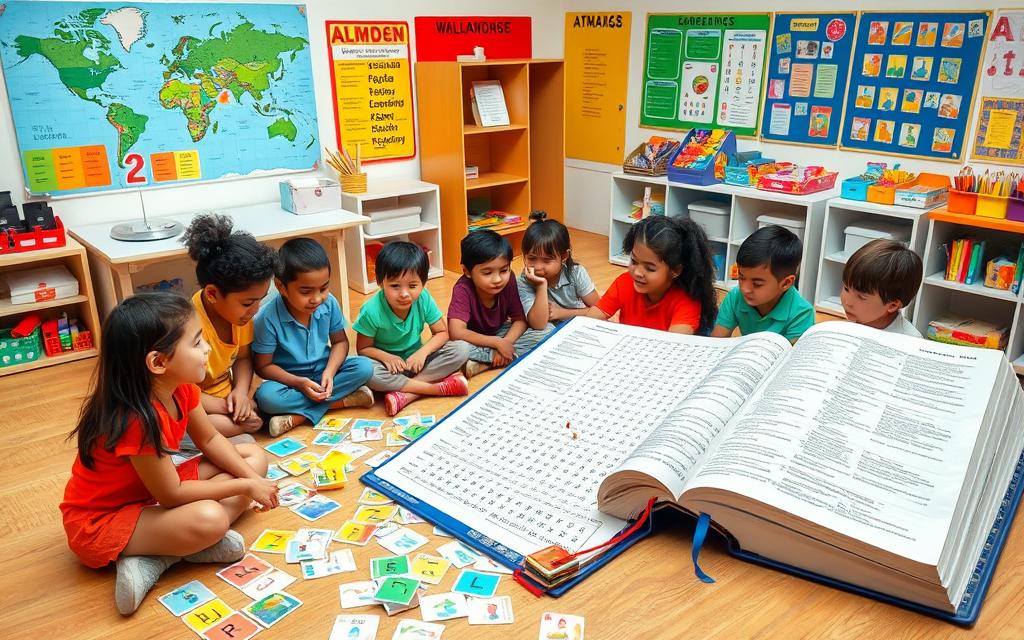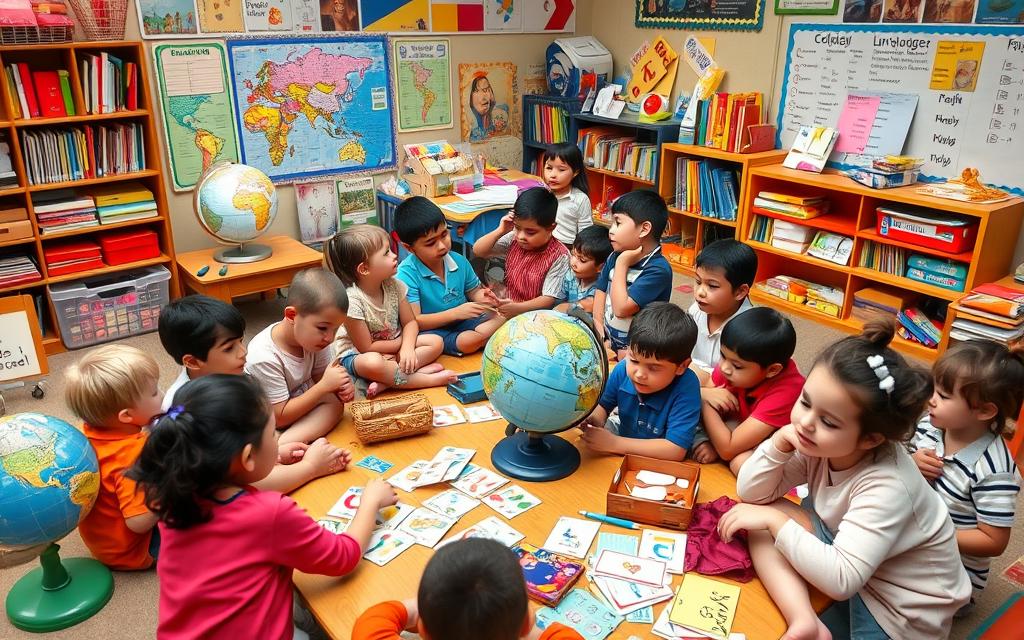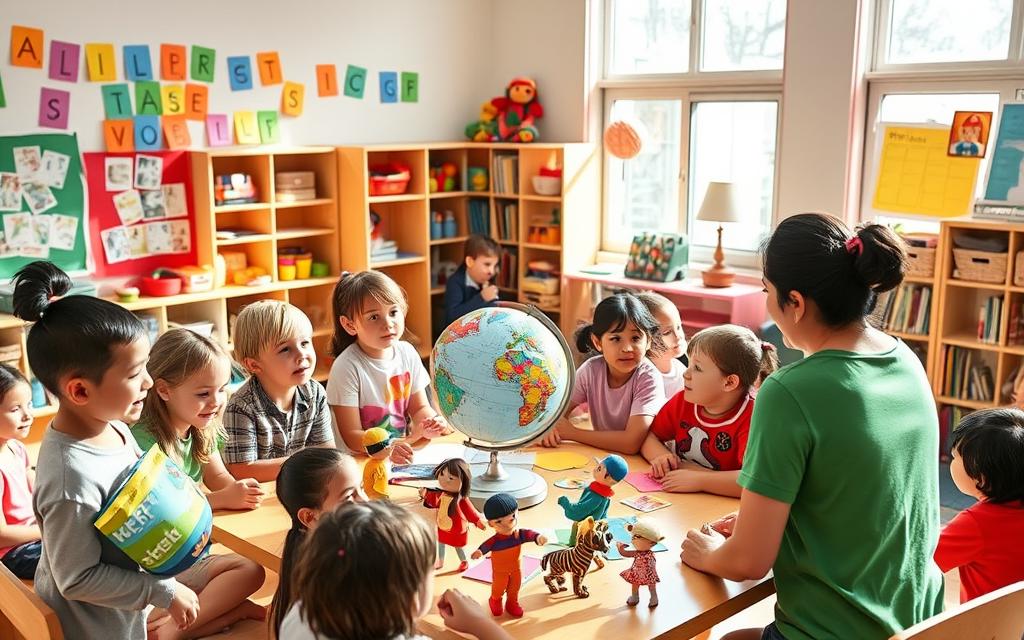Did you know kids are naturally good at learning new languages? Starting early, even while learning English, can help their brains grow. It’s important to include some fun ways to teach kids a foreign language, make learning fun and engaging for their language development.
This guide shows you how to teach kids a foreign language at home. It covers babies to 8-year-olds. You’ll find games, multimedia, and play-based learning that make learning fun.
Whether you’re a parent, caregiver, or teacher, this guide has what you need. It helps you teach language skills in a fun and educational way. You’ll get tips on vocabulary and cultural immersion to support your child’s multilingual journey.
Understand the Importance of Early Language Learning
Learning a new language early is key for kids’ brains. They can pick up languages quickly, making it a great time to start. Learning early sets a strong base for future learning and brings many benefits.
Immersive learning techniques and child-friendly language learning tools help a lot. Kids who learn two languages do better in listening, following directions, and speaking. They also get better at social skills. This early start helps them be flexible and understand different cultures.
“Playing is essential for teaching kids new languages as it helps in the faster acquisition of vocabulary and phrases.” – Amy, a teacher
The Economist says learning different languages helps kids think differently. It makes them more empathetic and open to other cultures. The American Academy of Neurology found that speaking two languages can even protect against dementia later in life.
Learning a new language early also opens doors for jobs around the world. As The Economist and Time point out, knowing multiple languages can make you more attractive to employers. It gives kids a special way to see the world, as The Guardian notes.
The role of immersive learning techniques and child-friendly language learning tools in early education is huge. By teaching kids to love language and see the world globally, we give them a head start. This benefits their minds, social skills, and future careers.
Create an Engaging Learning Environment at Home
Creating a fun and learning-friendly space at home is key for kids’ language growth. A special area for learning can spark their interest in new languages. It also helps them enjoy using language learning tools designed for kids.
Begin by setting up a mini library with books in the target language. Encourage your child to dive into these books. This helps them learn new words and get used to the language.
Next, add a play area with toys and art supplies. This space should help your child be creative while learning the language.
- Make learning fun with games, speaking practice, and interactive books.
- Use technology to make learning exciting and varied.
- Help your child label things at home in the new language. This boosts memory and learning.
Place the learning area near where your family hangs out. This way, learning the new language becomes part of daily life. It makes learning more fun and consistent.
“Early exposure to multiple languages can provide numerous cognitive and social benefits for children, setting the stage for lifelong language proficiency.”
Creating a welcoming learning space at home is vital. It helps your child love learning languages. With some creativity, your living room can become a place where languages come alive.

Fun Ways to Teach Kids a Foreign Language
Teaching kids a foreign language doesn’t have to be boring. There are many fun ways to teach kids a foreign language. You can use games and interactive drills to make learning fun and memorable.
Try to make language learning part of playtime. Talk about daily activities and introduce new words as you go. Play action games where you call out verbs and kids act them out. This makes learning a language fun and hands-on.
- Use fun flashcards to make vocabulary drills a daily joy.
- Implement the One Person One Language method, where each parent speaks a different language to the child. This immerses them in both languages early on.
- Explore ethnic restaurants and festivals together. This gives kids a deeper understanding of the language and its culture.
The secret to teaching kids a language is to make it fun. Use games, interactive activities, and cultural experiences. This way, kids can develop a love for languages that will benefit them all their lives.
“The greatest gift you can give a child is the ability to speak more than one language.” – Unknown
Use Technology and Multimedia Resources
In today’s world, technology and multimedia are key for teaching kids a new language. They offer everything from educational videos and podcasts to interactive apps and virtual tours. These tools make learning fun and engaging for kids.
Using multimedia during car rides or free time is a great idea. Videos or audio lessons in the target language can make learning fun. This is especially helpful for parents who don’t speak the language themselves.
- Tools like Newsela offer texts at five variable Lexile levels, including English and Spanish versions.
- Khan Academy provides curriculum translations in 12 languages.
- BrainPOP ELL offers a comprehensive online curriculum for language skill improvement.
- Read&Write is a text-to-speech app beneficial for various literacy needs, including ELLs.
While tech is useful, it’s also important to have hands-on activities. These activities help kids practice speaking and understanding the culture. By mixing tech with real-life experiences, we can create a well-rounded learning plan.
“Technology is a powerful tool, but it should be used judiciously to enhance, not replace, real-world language learning experiences.”
In short, tech and multimedia can help kids learn a new language. But, it’s important to use it with other teaching methods. This way, we can make learning fun and complete.

Incorporate Language Learning into Daily Routines
Adding language learning to your child’s daily life can make it fun and effective. For little ones, talk in the target language during simple tasks like dressing or bathing. This helps them link the new language to everyday life.
Make a special time each day for speaking in the target language at home. This works great for parents who speak the language but can also work for others. Just plan your day around using the new language.
- Watching dubbed films can be a fun way of learning a new language.
- Changing the display language on various devices can aid in language learning.
- Labeling objects in your environment with their corresponding foreign language names can facilitate vocabulary acquisition.
Short, regular language lessons are better than trying to cram it all into one session. Use small moments, like during commutes or doing chores, for learning. These moments add up and help a lot.
“Learning a new language can enhance a child’s CV and bolster college applications.”
Getting a language exchange partner is key to getting better at speaking. Doing hobbies in a foreign language is also a great way to practice and get better.

Play-Based Learning Strategies
Play is key for young children to learn new languages. Games and fun activities make learning a language exciting and effective.
Experts say to use play in daily tasks like getting dressed or eating. This way, kids learn to listen, follow directions, and grow their vocabulary. They also improve their social skills.
Choose toys that help with language, like Duplo blocks for colors, Schleich animals for names, and Grimm’s blocks for vocabulary. These interactive language games keep kids interested and help them learn a new language in a fun way.
“Play is the highest form of research.” – Albert Einstein
Research backs up the power of play in learning. For example, “Draw It Back to Me” boosts memory by nearly double. “A Shared Story” helps with speaking and listening.
- Play “Guess The Secret Word” to improve listening and remembering words.
- Try “Four Corners” to get kids talking and engaged in class.
- Use paper fortune tellers in “Fortune Teller” to start deep conversations.
Play-based learning makes learning fun and engaging. It helps kids not just learn a language but also develop important skills like communication and problem-solving.

Cultural Immersion Activities for Language Development
Introducing kids to different cultures can make learning a new language exciting. While traveling abroad is great, there are many local ways to do the same thing.
Going to cultural festivals, trying traditional foods, or seeing museum exhibits about other cultures can help kids learn a language. These activities make learning more fun and meaningful.
- Attend local cultural festivals to expose children to music, dance, and customs from around the world.
- Explore restaurants serving traditional dishes from the language they are learning to provide a sensory connection.
- Visit museum exhibits that highlight the art, history, and traditions of the language’s culture.
These language immersion activities for children help them understand different cultures and languages better. By using creative methods for teaching foreign languages to children, we can make learning more engaging and fun.
“Learning a language requires patience from teachers and learners, with a focus on speaking to enhance learning.”
Learning a new language takes time and practice. By doing cultural activities that match the language they’re learning, kids can get better and more excited about it.

Cultural immersion activities are an integral aspect of language development. By immersing oneself in a culture, language learners are able to fully understand and use the language in a natural and authentic way. In this blog post, we will explore some cultural immersion activities that can help enhance language development.
One popular cultural immersion activity is participating in language exchange programs. These programs pair native speakers with language learners, allowing them to practice speaking and listening in a real-world setting. Language exchange programs provide learners with the opportunity to engage in conversations with native speakers, learn idiomatic expressions, and improve their pronunciation.
Another cultural immersion activity is attending cultural events and festivals. By immersing oneself in the traditions, food, and music of a culture, language learners are able to better understand the context in which the language is used. Attending cultural events also provides learners with the opportunity to interact with native speakers and practice their language skills in a social setting.
Cooking traditional dishes from the target language’s culture is another effective cultural immersion activity. By preparing and tasting authentic dishes, language learners can engage all of their senses and gain a deeper understanding of the culture. Cooking traditional dishes also provides learners with the opportunity to learn vocabulary related to food and cooking in the target language.
Additionally, watching films and TV shows in the target language is a great way to immerse oneself in the language and culture. By watching movies and TV shows, language learners can improve their listening skills, learn colloquial expressions, and gain insight into the cultural nuances of the language.
Overall, cultural immersion activities are essential for language development. By engaging in activities that allow language learners to interact with native speakers, experience the culture, and practice using the language in authentic contexts, learners can significantly improve their language skills and gain a deeper appreciation for the target language and culture.
Age-Appropriate Teaching Methods and Tools
Teaching kids a foreign language needs a special touch. Each age group has its own needs and abilities. By tailoring your teaching, you can make learning fun and effective for kids.
Babies and toddlers (0-2 years) need lots of language exposure. Use songs, stories, and daily talk to teach them. Add fun tools like interactive toys and flashcards to keep them interested.
- Use toys that help with language, like shape sorters and picture books.
- Sing songs and nursery rhymes in the target language to help with sounds.
- Talk about your day in the foreign language to teach new words.
Preschool and early elementary kids (3-8 years) can handle more structured lessons. Flashcards and games make learning fun. Labeling objects around the house helps them remember new words.
“Children who learn a second language early often have better pronunciation and language skills than those who start later.”
Older kids (8-12 years) can learn more complex grammar and reading. Encourage them to use the language in real-life situations. This could be through role-playing or writing their own stories.
Remember, keep it fun and interactive for all ages. Using the right tools and methods can make kids love learning languages for life.

Build Vocabulary Through Interactive Games
Interactive language games are a great way to make learning fun for kids. These activities keep young learners engaged and help them grow their vocabulary. They do this in a natural, fun way.
Board Race is a game for ages 7-25. Teams race across a board, answering questions to move forward. Call My Bluff and Two Truths and A Lie are also good for speaking practice and can be used to break the ice.
Simon Says is a classic game for young learners. It helps with listening and vocabulary. Players must only follow instructions when “Simon says” to show they understand the language.
- Word Jumble Race: This game promotes teamwork and improves grammar and writing. Players unscramble words to form sentences.
- Bingo: A favorite game that helps with vocabulary and listening skills. It’s great for learning a new language.
- Charades: This activity boosts vocabulary and non-verbal skills. Students act out words or phrases from the lesson.
Using interactive language games makes learning a foreign language fun and engaging. These games mix fun with learning, helping kids build a strong vocabulary.

Maintain Motivation and Progress
Keeping kids interested in learning a new language is key. Use creative methods for teaching foreign languages to children to make it fun. This way, learning becomes an enjoyable experience.
Begin with bilingual books for storytime. Choose stories they already know. This helps them understand the new language better. Don’t worry if they make mistakes. Let them try new things without fear of being wrong.
Reading in the target language every day is important. It becomes a special time for your family. Celebrate their small wins to keep them excited about learning.
- Use bilingual books and start with familiar stories to provide a mental framework for the new language.
- Embrace imperfection in pronunciation and grammar, creating a safe space for learning.
- Read to your child in the target language daily, making it a special family time.
- Track progress and celebrate small victories to keep children engaged.
Positive and uncritical feedback plays an essential role in students feeling competent in language learning.
By using these engaging foreign language lessons for kids and creative methods for teaching foreign languages to children, you can keep your child motivated. This ensures they make steady progress in their language learning.

Teaching kids a foreign language can be fun and rewarding. It’s great for both parents and children. By adding fun activities and games to daily life, kids can learn a new language easily.
Consistency, patience, and a positive learning space are crucial. With the right approach, kids can gain valuable language skills. These skills will help them throughout their lives.
There are many ways to make learning a foreign language fun for kids. You can use digital tools, explore different cultures, or use play-based learning. This way, kids can develop a lifelong love for language.
Learning a new language early has many benefits. Multilingual kids often think better, solve problems more easily, and do well in school. By supporting their language learning, parents and teachers open doors to many opportunities.
Source Links
- 10 Fun ESL Games and Activities for Teaching Kids English Abroad – https://www.gooverseas.com/blog/10-best-games-esl-teachers
- 10 Apps and Websites to Help Kids Learn a Second Language – https://amshq.org/Blog/2024-07-22-10-Apps-and-Websites-to-Help-Kids-Learn-a-Second-Language
- Fun and easy ways to teach children a foreign language – Slummy single mummy – https://slummysinglemummy.com/2019/02/18/fun-and-easy-ways-to-teach-children-a-foreign-language/
- Why Play Matters When Teaching Kids a Language – https://www.theculturedkid.com/blog/why-play-matters-when-teaching-kids-a-language
- 6 reasons why language learning is important for children ‹ GO Blog | EF United States – https://www.ef.edu/blog/language/6-reasons-why-language-learning-is-important-for-children/
- Early Language Learning and Literacy: Neuroscience Implications for Education – https://pmc.ncbi.nlm.nih.gov/articles/PMC3164118/
- 7 creative ways to teach languages – https://www.bookwidgets.com/blog/2016/10/7-creative-ways-to-teach-languages
- 10 Tips for Teaching Young Dual Language Learners Effectively – https://brookespublishing.com/newsletters/early-childhood-newsletter/10-tips-for-teaching-young-dual-language-learners-effectively/?srsltid=AfmBOoqvhzNfbX72eCxBOf5G-s_RLYt8YQrmVNMdE3bP9mEYeDh4LueI
- Easy Ways to Teach Your Child a Foreign Language From 0-6 Years – https://www.theculturedkid.com/blog/nurture-language-development
- How to Teach Kids a Foreign Language with Activities – Novak Djokovic Foundation – https://novakdjokovicfoundation.org/foreign-language-activities/
- 5 fun language learning activities for children – https://5minutelanguage.com/2019/05/01/5-fun-language-learning-activities-for-kids/
- How to Use Technology to Support ELLs in Your Classroom | Common Sense Education – https://www.commonsense.org/education/articles/how-to-use-technology-to-support-ells-in-your-classroom
- Using Multimedia Resources – https://www.colorincolorado.org/teaching-ells/ell-classroom-strategy-library/using-multimedia-resources
- How To Integrate Language Learning Into Daily Life – https://www.babbel.com/en/magazine/how-to-integrate-language-learning-into-daily-life
- Here’s how to help your child learn a new language faster – 5 tips ‹ EF GO Blog | EF Global Site (English) – https://www.ef.com/wwen/blog/language/how-to-help-your-child-learn-a-new-language-faster/
- 14 Ways to Help Kids Learn Vocabulary in a New Language – https://marocmama.com/14-ways-to-help-kids-learn-vocabulary-in-a-new-language/
- 17 Fun Games to Get World Language Learners Talking – https://www.edutopia.org/article/17-fun-games-to-get-world-language-learners-talking/
- Play-Based Learning: What Research Tells | Teaching Strategies – https://teachingstrategies.com/blog/rigor-through-play-based-learning/
- Layout 1 – https://fpcc.ca/wp-content/uploads/2020/08/language-immersion-handbook.pdf
- 8 Ways to Support Children in Language Immersion – https://www.participatelearning.com/blog/8-ways-to-support-your-children-in-language-immersion/
- Foreign language teaching methods to help children speak fluently | Allison Academy – https://www.allisonacademy.com/parents/parenting/foreign-language-teaching-methods/
- How to teach languages to different age groups – https://sanako.com/how-to-teach-languages-to-different-age-groups
- 10 Tips for Teaching Young Dual Language Learners Effectively – https://brookespublishing.com/newsletters/early-childhood-newsletter/10-tips-for-teaching-young-dual-language-learners-effectively/?srsltid=AfmBOopnV4lG7zix-XMYmG4nqoV4JyMyup8HAFEwBzKdvOGdTSsiwx5r
- 16 Language Learning Games & Activities: Fun & Effective – https://preply.com/en/blog/at-home-language-learning-games/
- Favorite Game for World Language Classrooms – La Maestra Loca – https://www.lamaestraloca.com/2022/04/04/favorite-game-for-world-language-classrooms/
- Six great language learning games to try in your classroom – https://sanako.com/six-great-language-learning-games-to-try-in-your-classroom
- Motivating Students in World Language Classes – Kid World Citizen – https://kidworldcitizen.org/motivating-students-in-world-language-classes/
- 7 strategies to increase motivation in your language learners – https://sanako.com/7-strategies-to-increase-motivation-in-your-language-learners
- How to learn a language WITH your kids! – https://www.theculturedkid.com/blog/how-to-learn-a-language-with-your-kids
- 6 Fun Ways To Practice A New Language Outside The Classroom | Aralia – https://www.aralia.com/helpful-information/practice-a-new-language/
- 5 Fun Ways To Improve Your Kids Language Learning – https://timemaster.ae/news-and-articles/language-learning-activities-for-kids



